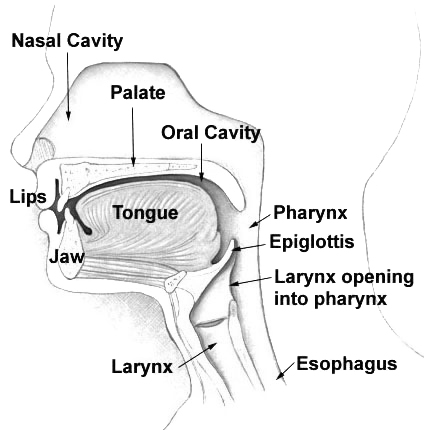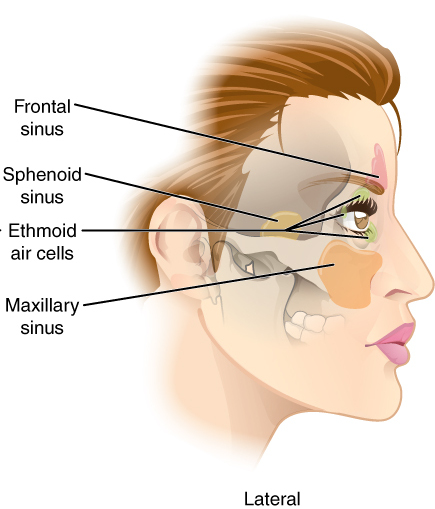|
Sphenoethmoidal Recess
The sphenoethmoidal recess is a small triangular space superior to the superior nasal meatus of the nasal cavity into which the sphenoidal sinus opens. The sphenoethmoidal recess is situated supero posterior to the superior nasal concha The superior nasal concha is a small, curved plate of bone representing a medial bony process of the labyrinth of the ethmoid bone. The superior nasal concha forms the roof of the superior nasal meatus. Anatomy Anatomical relations The super ..., between the superior nasal concha and the anterior aspect of the body of the sphenoid bone. Anatomy Variation When present, the supreme nasal concha is situated upon the lateral wall of the sphenoethmoid recess, with the supreme nasal meatus created below it occasionally presenting an opening of the posterior ethmoidal sinus. References External links * - "The turbinates have been cut and removed to illustrate the meatus and openings into them." Nose {{respiratory-stub ... [...More Info...] [...Related Items...] OR: [Wikipedia] [Google] [Baidu] |
Nasal Cavity
The nasal cavity is a large, air-filled space above and behind the nose in the middle of the face. The nasal septum divides the cavity into two cavities, also known as fossae. Each cavity is the continuation of one of the two nostrils. The nasal cavity is the uppermost part of the respiratory system and provides the nasal passage for inhaled air from the nostrils to the nasopharynx and rest of the respiratory tract. The paranasal sinuses surround and drain into the nasal cavity. Structure The term "nasal cavity" can refer to each of the two cavities of the nose, or to the two sides combined. The lateral wall of each nasal cavity mainly consists of the maxilla. However, there is a deficiency that is compensated for by the perpendicular plate of the palatine bone, the medial pterygoid plate, the labyrinth of ethmoid and the inferior concha. The paranasal sinuses are connected to the nasal cavity through small orifices called ostia. Most of these ostia communicat ... [...More Info...] [...Related Items...] OR: [Wikipedia] [Google] [Baidu] |
Superior Nasal Meatus
In anatomy, the term nasal meatus can refer to any of the three meatuses (passages) through the skulls nasal cavity: the superior meatus (''meatus nasi superior''), middle meatus (''meatus nasi medius''), and inferior meatus (''meatus nasi inferior''). The nasal meatuses are the spaces beneath each of the corresponding nasal conchae. In the case where a fourth, supreme nasal concha is present, there is a fourth supreme nasal meatus. Structure The superior meatus is the smallest of the three. It is a narrow cavity located obliquely below the superior concha. This meatus is short, lies above and extends from the middle part of the middle concha below. From behind, the sphenopalatine foramen opens into the cavity of the superior meatus and the meatus communicates with the posterior ethmoidal cells. Above and at the back of the superior concha is the sphenoethmoidal recess which the sphenoidal sinus opens into. The superior meatus occupies the middle third of the nasal cavity’ ... [...More Info...] [...Related Items...] OR: [Wikipedia] [Google] [Baidu] |
Sphenoidal Sinus
The sphenoid sinus is a paired paranasal sinus in the Body of sphenoid bone, body of the sphenoid bone. It is one pair of the four paired paranasal sinuses.Illustrated Anatomy of the Head and Neck, Fehrenbach and Herring, Elsevier, 2012, page 64 The two sphenoid sinuses are separated from each other by a septum. Each sphenoid sinus communicates with the nasal cavity via the opening of sphenoidal sinus. The two sphenoid sinuses vary in size and shape, and are usually asymmetrical. Structure On average, a sphenoid sinus measures 2.2 cm vertical height, 2 cm in transverse breadth; and 2.2 cm antero-posterior depth. Each spehoid sinus is in the body of sphenoid bone, just under the sella turcica. The sphenoid sinuses are separated from each other medially by the septum of sphenoidal sinuses, which is usually asymmetrical. An opening of sphenoidal sinus forms a passage between each sphenoidal sinus and the nasal cavity. Posteriorly, an opening of sphenoidal sinus opens ... [...More Info...] [...Related Items...] OR: [Wikipedia] [Google] [Baidu] |
Anatomical Terms Of Location
Standard anatomical terms of location are used to describe unambiguously the anatomy of humans and other animals. The terms, typically derived from Latin or Greek roots, describe something in its standard anatomical position. This position provides a definition of what is at the front ("anterior"), behind ("posterior") and so on. As part of defining and describing terms, the body is described through the use of anatomical planes and axes. The meaning of terms that are used can change depending on whether a vertebrate is a biped or a quadruped, due to the difference in the neuraxis, or if an invertebrate is a non-bilaterian. A non-bilaterian has no anterior or posterior surface for example but can still have a descriptor used such as proximal or distal in relation to a body part that is nearest to, or furthest from its middle. International organisations have determined vocabularies that are often used as standards for subdisciplines of anatomy. For example, '' Termi ... [...More Info...] [...Related Items...] OR: [Wikipedia] [Google] [Baidu] |
Superior Nasal Concha
The superior nasal concha is a small, curved plate of bone representing a medial bony process of the labyrinth of the ethmoid bone. The superior nasal concha forms the roof of the superior nasal meatus. Anatomy Anatomical relations The superior nasal concha is situated posterosuperiorly to the middle nasal concha. It forms the superior boundary of the superior nasal meatus. Superior to the superior nasal concha is the sphenoethmoidal recess where the sphenoid sinus communicates with the nasal cavity; the sphenoethmoidal recess is interposed between the superior nasal concha, and (the anterior aspect of) the body of sphenoid bone. The sphenoid sinus ostium exists medial to the superior turbinate. See also * Nasal concha In anatomy, a nasal concha (; : conchae; ; Latin for 'shell'), also called a nasal turbinate or turbinal, is a long, narrow, curled shelf of bone tissue, bone that protrudes into the breathing passage of the nose in humans and various other anim ... Add ... [...More Info...] [...Related Items...] OR: [Wikipedia] [Google] [Baidu] |
Body Of The Sphenoid Bone
The body of the sphenoid bone, more or less cubical in shape, is hollowed out in its interior to form two large cavities, the sphenoidal sinuses, which are separated from each other by a septum. Superior surface The superior surface of the body ig. 1presents in front a prominent spine, the ethmoidal spine, for articulation with the cribriform plate of the ethmoid bone; behind this is a smooth surface slightly raised in the middle line, and grooved on either side for the olfactory lobes of the brain. This surface is bounded behind by a ridge, which forms the anterior border of a narrow, transverse groove, the prechiasmatic groove, above and behind which lies the optic chiasma; the groove ends on either side in the optic foramen, which transmits the optic nerve and ophthalmic artery into the orbital cavity. Behind the chiasmatic groove is an elevation, the tuberculum sellae; and behind this is a deep depression, the saddle-shaped sella turcica (Turkish seat), the deepest pa ... [...More Info...] [...Related Items...] OR: [Wikipedia] [Google] [Baidu] |
Supreme Nasal Concha
The supreme nasal concha or highest nasal concha is a nasal concha (turbinate) that occurs in some cases. It is shaped like a seashell and found on the posterosuperior part of the lateral nasal wall.Supreme nasal concha. (n.d.) ''Medical Dictionary for the Health Professions and Nursing.'' (2012). Retrieved April 16, 2015 fro/ref> It lies on the medial surface of the labyrinth of ethmoid above the superior nasal concha. This makes it the highest of the nasal conchae, and the highest of three on the ethmoid bone. It is often no more than a small, simple crest protruding from the nasal wall. The space below and the fissure lateral to the concha are known as the supreme nasal meatus. It was historically known as Santorini's concha, after Giovanni Domenico Santorini.Supreme nasal concha. (n.d.) ''Medical Eponyms''. (2012). Retrieved April 16, 2015 fro/ref> See also * Nasal concha In anatomy, a nasal concha (; : conchae; ; Latin for 'shell'), also called a nasal turbinate or turbi ... [...More Info...] [...Related Items...] OR: [Wikipedia] [Google] [Baidu] |


